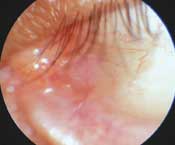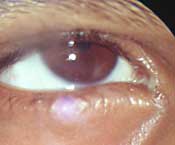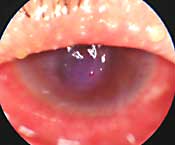Dry eye, allergies prevalent in India among different age groups
Education, thorough follow-up and varying treatment regimens are several ways that dry eye and ocular allergies can be successfully treated in Indian patients, according to physicians.
Dry eye and ocular allergies are common among varying age groups, affecting them in different ways. Experts estimate that up to 20% of patients older than 40 years could have dry eye in India, and more than 25% of patients older than 65 years could have the condition.
One hospital-based epidemiological study by Sahai and Malik found an 18.4% prevalence of dry eye in a population of 500 patients, increasing to a prevalence of 36% in patients older than 70 years. The researchers concluded that dry eye is an under-diagnosed ocular disorder.
Allergies are also a common ocular condition, especially affecting children in India, and can co-exist with asthma and skin allergies.
 Quresh B. Maskati |
Many patients do not seek help from ophthalmologists for dry eye or allergy ocular conditions. Instead, they use a variety of medications from the chemist or other places to treat their conditions, according to Quresh B. Maskati, MS, DOMS, FCPS, FICS. He estimated that less than 10% of patients who are prescribed treatment use tear medications. Others use medications such as antibiotics, antibiotic-steroid combinations, steroids, nonsteroidal anti-inflammatory drugs, vasoconstrictors and anti-allergic drops.
In an interview with Ocular Surgery News, Dr. Maskati said he recommends that people seek treatment from ophthalmologists and take an active role in alleviating their ocular conditions.
“In my practice, for all cases of dry eye, I would advocate lifestyle changes to the extent possible, treat any co-existing lesions, such as blepharitis or meibomian gland disease, and prescribe lubricant drops,” he said.
Dry eye treatment
Dr. Maskati said he sees many cases of dry eye caused by pollution, prolonged computer use and complications from surgery or laser procedures. He treats each case on an individual basis but tends to prescribe similar regimens for patients with similar severity of the condition.
For patients with mild dry eye that requires fewer than four drops a day, he prescribes drops with preservatives because he is less concerned with preservative toxicity in those cases. However, he monitors those patients for signs of toxicity. He also changes the brand of eye drops to switch preservatives in a bid to prevent preservative toxicity, he said.
For patients with moderate dry eye, Dr. Maskati said he places them on preservative-free drops or drops with “disappearing preservatives.”
He also puts patients on Restasis (cyclosporine ophthalmic emulsion, Allergan) twice a day for 1 to 2 years. He conducted a study on 60 eyes of 30 Asian patients with moderate dry eye using cyclosporine ophthalmic emulsion and found that the product was well-tolerated, with no serious topical adverse effects or systemic side effects.
After 2 months of cyclosporine ophthalmic emulsion usage, if the inflammatory component has been reduced, Dr. Maskati often inserts collagen plugs in the puncta. If insertion of the plugs results in significantly better results, he then inserts a permanent plug or performs a punctum cauterization a week later.
 Samar K. Basak |
Samar K. Basak, MD, DNB, FRCS, said in an interview with OSN that he also prescribes tear substitutes with or without preservatives for mild dry eye cases.
“Besides this, advise [patients] to avoid environmental factors, treating the primary cause if any,” he said.
For patients with moderate dry eye, he recommends a tear substitute with sodium perborate or Purite preservative, six to 10 times, depending on the response; cyclosporine ophthalmic emulsion twice daily; and loteprednol. Also, he may prescribe a tear gel preparation at night, he said.
“We also treat meibomianitis by oral doxycycline, erythromycin eye ointment and teach about lid hygiene,” Dr. Basak said.
Dry eye compliance
Even with the best treatment possible, compliance issues can have a major impact on the results of dry eye therapy, Dr. Maskati said. Discussing not only treatments but also the possible cause or causes of dry eye with patients is especially important because they must know how to stop future dry eye problems.
“In India, there is a surfeit of lubricant medications available. There is no one type of drops which suits all. Each patient will have to go through a process of trial and error to decide which active component of the drops gives him/her the best relief,” Dr. Maskati said. “However, this should be supervised by the ophthalmologist after giving the patient enough information about the disease. Otherwise, the patient, finding no relief with one brand, goes doctor-shopping and often lands up in my clinic after having tried a dozen brands, ending up with keratoconjunctivitis medicamentosa.”
He said talking to patients about the process of reducing their dry eye is of key importance to best results.
“Simply prescribing a brand of lubricants and sending the patient out of the clinic is a recipe for disaster,” he said. “The patients have to be told that dry eye is a disease in which the treatment is long and drawn-out.”
 Early ocular cicatricial pemphigoid can be a dry eye complication. |
 One symptom in some dry eye patients is discharge. |
 Allergic conjuctivitis is one of the conditions commonly seen in Dr. Maskati’s office. |
Allergy treatment
Although allergies are also common in India, ocular allergy conditions differ from dry eye in that they often affect younger age groups, physicians said.
Dr. Maskati said patients in India often have problems with perennial allergies that are yearlong with flare-ups and remissions, unlike the typical seasonal allergies in the West.
Allergic conjunctivitis is one of the most typical problems that Dr. Basak treats in his practice. He also treats many young children with vernal keratoconjunctivitis, at a rate of about six to eight patients daily in the summer and two to three a week in the winter, he said. The allergic disease occurs in a severe form in India and can lead to blindness from corneal complications, including shield ulcer, dry eye and keratoconus.
“This severe form is much less common in the Western world,” he said.
Dr. Basak attributes allergies in India to dust, pollen grains and environmental pollutants. Dr. Maskati said mites and cockroach residues also pose allergen risk factors.
For milder acute allergy cases, Dr. Basak said he prescribes oral and topical antihistamines and a tear substitute. Also, he sometimes prescribes diluted steroid drops for several days. For chronic or perennial allergy cases, he prescribes loteprednol for a short time, a topical mast cell stabilizer or a topical dual-acting anti-allergic, either olopatadine or epinastine, and also a tear substitute.
“Dual-acting anti-allergic preparation is preferred by many ophthalmologists in the country,” he said.
For vernal conjunctivitis cases, Dr. Basak also uses pulse therapy with strong topical steroids, followed by soft steroids and topical dual-acting anti-allergic drugs, including olopatadine or epinastine, and a tear substitute. For severe cases, he gives a supratarsal injection of depot steroids (triamcinolone acetonide) for prolonged action.
He also monitors IOP at follow-up visits, he said.
Dr. Maskati said dual-action drugs act as mast cell stabilizers as well as antihistamines and are effective in overall management of allergies. Therefore, steroids can be used just for those times when acute attacks call for short bursts of therapy.
“Some patients may benefit from concurrent use of lubricants. These wash out allergens as well as supplement the patients’ own tears, which may be reduced due to long-term topical anti-allergic medication,” Dr. Maskati said.
Allergy compliance
As with dry eye, compliance also plays an important role in allergy treatment, Dr. Maskati said. He advises patients to use dual-action drugs twice a day continuously for at least a year, regardless of symptoms.
For those patients who have an acute allergy attack, he encourages them to use a low-strength soft steroid and then a nonsteroidal drop until the attack ends.
“I explain to them that this is an effort to gradually desensitize the eye to the allergen. I feel even illiterate patients will understand the need for medication if the doctor takes the trouble to explain the rationale of treatment,” Dr. Maskati said.
Talking to patients helps them better understand the why and how behind their ocular conditions and treatment, and it makes them more apt to follow instructions and use their medications. As a result, he said he finds that his patient compliance rate is high. — by Erin L. Boyle
For more information:
- Sahai A, Malik P. Dry eye: prevalence and attributable risk factors in a hospital-based population. Indian J Ophthalmol. 2005; 53:87-91.
